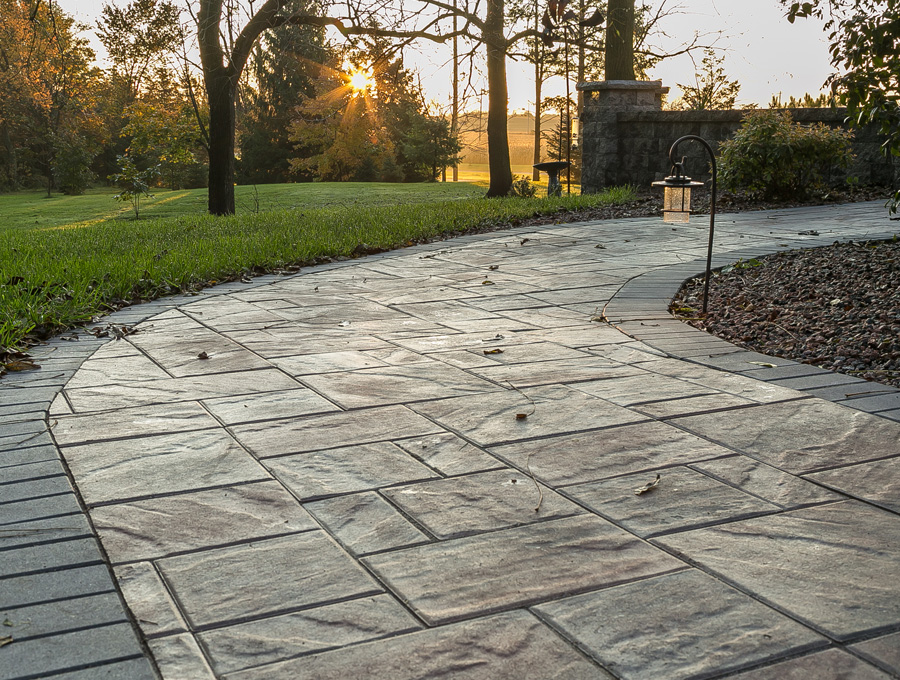How to Choose Between Pavers or Concrete for Your Next Patio

Whether you’re installing a walkway, patio, pool deck or driveway, it can be hard to know which materials are right for your project. In most situations, homeowners can choose from concrete (including stamped concrete) or concrete pavers.
Here’s what you need to know to choose between these options to create a hardscape that will last for years to come and get your return on investment.
What is concrete?
A standard slab of concrete is usually a layer of three to four inches (sometimes more) of concrete poured to cover your hard surfaced area. This includes stamped concrete, which is finished with decorative textures to resemble flagstone, brick, wood, and others.
What are pavers?
Pavers are manufactured concrete paving stones. They’re typically created with the same ingredients as concrete, but go through a process that presses them into paving stones. Pavers are often called “concrete pavers” or “brick pavers.”
What to consider when choosing between concrete and pavers
Cost. Concrete is significantly less expensive than pavers. Although pavers cost more on the front end, they often last longer and require less maintenance than concrete. Over the lifetime of your landscape, the cost of pavers can be similar to or even lower than the cost of concrete.
Strength. Concrete tends to settle and crack under pressure. Because pavers are compressed concrete, they are two to three times stronger than standard poured concrete.
Flexibility. Pavers and concrete are both made of cement, but pavers are far more flexible than concrete. Pavers will rise and fall through the freeze-thaw cycles in Wisconsin. It’s also much easier to add new elements or repair the hardscape with pavers – just remove or repair individual sections without redoing the entire patio or walkway.
Durability. Brick Pavers are designed to withstand freeze-thaw cycles and heavy loads, such as cars, trucks and even semi’s. Stamped or colored concrete often fades or chips away with time, especially in cold Wisconsin winters. Deicing salt also eats away at concrete and stamped concrete coloring over time.
Permeability. Pavers come in permeable options that allow driveways or patios to flow rainwater back into the earth rather than into storm sewers or home foundations. Permeable pavers have larger gaps between the stones, which allows water to rapidly drain through the surface into a gravel base before it’s absorbed by the ground. Concrete is not permeable and, if not installed properly, can direct rainwater to the foundation of your home.
Maintenance and repairs. Pavers and concrete are equally low-maintenance, but repairs are more challenging with concrete. A large area around the damage must be cut and removed, then fresh concrete must be re-poured into the area. With pavers, you can simply replace a damaged paver without disrupting the entire area.
Warranty. Many manufacturers include a warranty on pavers, giving you peace of mind that your investment will stand the test of time. Concrete is rarely, if ever, protected by a warranty.
Best practices for both pavers and concrete
Quality starts in the base. No matter what material you choose, the most important part of a patio, driveway or firepit is the base. This is typically composed of a layer of crushed stone material, such as gravel, that acts as a support between the dirt below and the concrete slab or stone pavers on top. The base reduces settling and cracking of concrete, and promote drainage.
The more base, the better. The industry standard for a base is twelve inches of crushed stone under a driveway, six inches under a patio, and four inches under a walkway. But The Reesman Company usually recommends adding a few extra inches of stone to the base to prevent flexing during the freeze-thaw cycle, which can prevent cracking. Two extra inches of relatively inexpensive stone is a better investment than replacing or repairing cracked or broken hardscape. The Reesman Company uses its engineering capability to correctly identify the soil to apply an accurate base thickness.
PRO TIP: Make sure your contractor uses open aggregate stone and not a sand and gravel mix as a base. The sand will retain moisture, which will lead to cracks and settling in the future.
Know your ground. Understanding the ground beneath the base is the first step in building a patio or hardscape element that will last a lifetime.
Seal it. Whether you’re working with concrete or pavers, sealing the material will help repel stains, reduce dust, resist abrasions, prevent water and deicing salts from entering the stone, and maintain its appearance for years to come.
Work with a pro. Regardless of the material you choose, you should always work with a professional landscape contractor to have your outdoor project installed.
At The Reesman Company, we design and build custom patios and hardscapes that add function, style and curb appeal while increasing your outdoor living space. We can help you assess your situation to determine the right materials that will make your yard the oasis you’ve always wanted. Call 262-539-2124 to speak with one of our landscape professionals or contact us for more information on how to keep your yard beautiful all year long.



